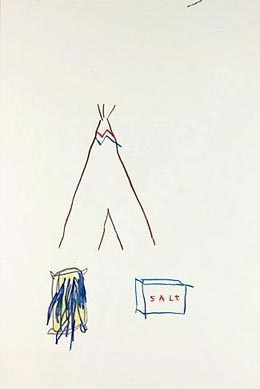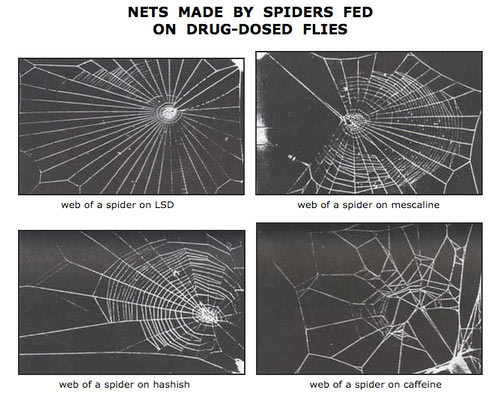health
animals, asia, halves-pairs, health | September 9th, 2011 2:05 pm

‘“Most people are simply not designed to eat pasta:” evolutionary explanations for obesity in the low-carbohydrate diet movement
Low-carbohydrate diets, notably the Atkins Diet, were particularly popular in Britain and North America in the late 1990s and early 2000s. On the basis of a discourse analysis of bestselling low-carbohydrate diet books, I examine and critique genetic and evolutionary explanations for obesity and diabetes as they feature in the low-carbohydrate literature. Low-carbohydrate diet books present two distinct neo-Darwinian explanations of health and body-weight. First, evolutionary nutrition is based on the premise that the human body has adapted to function best on the diet eaten in the Paleolithic era. Second, the thrifty gene theory suggests that feast-or-famine conditions during human evolutionary development naturally selected for people who could store excess energy as body fat for later use. However, the historical narratives and scientific arguments presented in the low-carbohydrate literature are beset with generalisations, inconsistencies and errors.
{ SAGE | Continue reading }
related { Habit makes bad food too easy to swallow }
controversy, food, drinks, restaurants, health, science | September 5th, 2011 3:00 pm

Stimulus Control Therapy consists of six very straightforward steps. If you follow these it should improve your sleep.
1. Lie down to go to sleep only when you are sleepy.
2. Do not use your bed for anything except sleep; that is, do not read, watch television, eat, or worry in bed. Sexual activity is the only exception to this rule. On such occasions, the instructions are to be followed afterwards, when you intend to go to sleep.
3. If you find yourself unable to fall asleep, get up and go into another room. Stay up as long as you wish and then return to the bedroom to sleep. Although we do not want you to watch the clock, we want you to get out of bed if you do not fall asleep immediately. Remember the goal is to associate your bed with falling asleep quickly! If you are in bed more than about 10 minutes without falling asleep and have not gotten up, you are not following this instruction.
4. If you still cannot fall asleep, repeat step 3. Do this as often as is necessary throughout the night.
5. Set your alarm and get up at the same time every morning irrespective of how much sleep you got during the night. This will help your body acquire a consistent sleep rhythm.
6. Do not nap during the day.
{ PsyBlog | Continue reading }
guide, sleep | September 5th, 2011 3:00 pm

The majority of people reading this sentence will, at some point in their lives, undergo a medical treatment that requires general anesthesia. Doctors will inject them with a drug, or have them breathe it in. For several hours, they will be unconscious. And almost all of them will wake up happy and healthy.
We know that the general anesthetics we use today are safe. But we know that because they’ve proven themselves to be safe, not because we understand the mechanisms behind how they work. The truth is, at that level, anesthetics are a big, fat question mark.
{ Boing Boing | Continue reading }
health, mystery and paranormal, sleep | September 1st, 2011 4:05 pm

No person can feel exactly how another person feels. No matter how much training in communication you might have and how much attention and time you spend listening to another person you will never fully be able to grasp all the aspects of the other person’s inner experience. By listening to the other person you might get an idea, a feeling of understanding. But what you feel will always in some way be referenced to your own experiences. By consciously and subconsciously observing the other person’s body language you might add another aspect to the understanding of the situation. However the perception will always be interpreted in your own complex framework of feelings and expectations – and as such the other person’s feelings could be misunderstood. These be the feelings about religion, political views, love, child rearing – or pain.
When it comes to pain this challenge in communication is extremely important. Although it is a terribly present and at times all consuming sensation to the sufferer, no doctor, nurse or even spouse can ever feel it. And yet it is most often another person than the sufferer who holds the key to the alleviation of the pain.
Feeling understood, feeling accepted, feeling heard and feeling trusted are essential feelings for most people in many aspects of life. When it comes to suffering an illness, this in some way has its own healing power. Likewise mistrust and feeling denied or dismissed might increase the suffering.
{ DoloTest | Continue reading }
photo { Diane Arbus }
health, relationships | August 19th, 2011 5:05 pm
drugs, haha | August 19th, 2011 9:21 am

Most bacterial infections can be treated with antibiotics such as penicillin, discovered decades ago. However, such drugs are useless against viral infections, including influenza, the common cold, and deadly hemorrhagic fevers such as Ebola.
Now, in a development that could transform how viral infections are treated, a team of researchers at MIT’s Lincoln Laboratory has designed a drug that can identify cells that have been infected by any type of virus, then kill those cells to terminate the infection.
researchers tested their drug against 15 viruses, and found it was effective against all of them — including rhinoviruses that cause the common cold, H1N1 influenza, a stomach virus, a polio virus, dengue fever and several other types of hemorrhagic fever.
The drug works by targeting a type of RNA produced only in cells that have been infected by viruses. “In theory, it should work against all viruses,” says Todd Rider, a senior staff scientist in Lincoln Laboratory’s Chemical, Biological, and Nanoscale Technologies Group who invented the new technology.
{ MIT | Continue reading | Thanks Glenn! }
health, science | August 15th, 2011 3:48 pm

One potential contributing factor to increasing rates of overweight and obesity is the availability and affordability of a wide range of food choices. A variety of inexpensive fast food options provides consumers the ability to rotate restaurant selection and reduce the risk of monotony in food selection.
Animal studies demonstrate that animals provided the same types of food (or other types of rewards) tend to reduce the level of consumption. This is a behavioral trait known as habituation. Habituation represents the tendency to reduce total caloric intake when eating the same foods and to increase caloric intake when presented novel food choices. (…)
If you are interested in losing weight, eating the same thing daily may be a way to use the habituation process to aid calorie restriction.
{ Brain Posts | Continue reading }
photo { Brian Ulrich }
food, drinks, restaurants, guide, health, science | August 4th, 2011 3:25 pm

A tiny molecule harvested from a soil bacterium on Easter Island that evolved billions of years ago for no obvious purposes should have nothing to do with human beings. Yet it turns out miraculously to have potent immunosuppressive properties that allow doctors to successfully perform a liver transplant in a young girl.
In India, an excited young bride celebrates her upcoming wedding by coloring her hands bright yellow with turmeric, a spice that has been used for centuries as a key culinary ingredient. In France, a similar hallowed tradition demands a copious flow of red wine at weddings. In China, a bride and groom offer ginseng tea to their parents as part of a ritual.
Oblivious of all these events, thousands of miles away in the United States, scientists are struck by the remarkable effect that the active ingredients in turmeric, red wine and ginseng tea seem to have on a variety of disorders, from cancer to Alzheimer’s disease. Perhaps, they ardently hope, there’s a cure in there somewhere.
Chemistry is the human science. What the general public refers to as “chemicals” have a profound effect on our way of life. They can forge a bridge between the metabolism of a billion year-old sponge and the fervent hopes of a mother for her daughter’s life, between the joy of traditional weddings and food and that of seeing a loved one being cured of a terrible malady. Physics may concern itself with the beginnings of deep time and biology turns its eye on the origin of humanity itself. The wonders of physics and biology are undoubtedly spectacular, but chemistry is the science that most directly engages with our senses, the discipline that confronts us face-on every single day of our lives and demands that we react.
{ Scientific American | Continue reading }
painting { Alex Brown, The Michael Channel, 2010 }
health, science | August 2nd, 2011 10:35 pm

Scalp hair grows, on average, at a rate of about half an inch per month, and shampoos or vitamins have not been shown to noticeably change this rate. Hair growth rate also depends upon what phase in the cycle of hair growth one is actually in; there are three phases:
• anagen is the growth phase;
• catagen is the involuting or regressing phase;
• telogen, the resting or quiescent phase.
Scalp (different hair color and follicle shape affects the timings of these phases):
• anagen phase, 2–3 years (occasionally much longer)
• catagen phase, 2–3 weeks
• telogen phase, around 3 months
Eyebrows, eyelashes, arms, legs, etc:
• anagen phase, about 30-45 days
• catagen phase, 3–4 weeks
• telogen phase, about 9 months
{ Wikipedia | eMedecine }
related { What’s the purpose of pubic hair? }
photo { Chad Muthard }
hair | July 22nd, 2011 8:48 pm

For decades, policy makers have tried and failed to get Americans to eat less salt. (…)
This week a meta-analysis of seven studies involving a total of 6,250 subjects in the American Journal of Hypertension found no strong evidence that cutting salt intake reduces the risk for heart attacks, strokes or death in people with normal or high blood pressure.
In May, European researchers reported that the less sodium that study subjects excreted in their urine—an excellent measure of prior consumption—the greater their risk was of dying from heart disease.
These findings call into question the common wisdom that excess salt is bad for you, but the evidence linking salt to heart disease has always been tenuous.
{ Scientific American | Continue reading }
drawing { Jean-Michel Basquiat, Salt, 1981 }
food, drinks, restaurants, health | July 18th, 2011 8:01 pm
health, photogs | July 15th, 2011 2:49 pm

You probably already know whether you’re a morning or evening person, but if you’re not sure, here are two ways to figure it out:
1) On weekends, or when you don’t have to wake up at any particular time, when do you naturally wake up? If the answer is more than an hour or so different from when you wake up on weekdays, chances are you’re an evening person by nature. Morning people tend to wake up just as early on weekends as they do during the week.
2) Regardless of how much sleep you’ve gotten, when do you find that you have the most energy? If your energy peaks in the morning and dwindles by late afternoon, you’re a morning person. If it peaks later in the evening - you guessed it - you’re an evening person. (…)
The debate over whether it’s better to be a night owl or an early bird has been going on for centuries. (…) Research on the advantages and disadvantages of each “chronotype” has yielded mixed results, in part because it is difficult to conduct this research experimentally. (…)
Evolutionary psychologists have suggested that a preference for late hours may suggest a higher level of intelligence because being a night owl is presumably an evolutionary novel preference, though this hypothesis is controversial.
{ Psych Your Mind | Continue reading }
painting { Edward Hopper, Summer Interior, 1909 }
guide, psychology, sleep | July 15th, 2011 12:38 am

In the late 1990s, Jane Anderson was working as a landscape architect. That meant she didn’t work much in the winter, and she struggled with seasonal affective disorder in the dreary Minnesota winter months. She decided to try meditation and noticed a change within a month. “My experience was a sense of calmness, of better ability to regulate my emotions,” she says. Her experience inspired a new study which will be published in an upcoming issue of Psychological Science, a journal of the Association for Psychological Science, which finds changes in brain activity after only five weeks of meditation training.
Previous studies have found that Buddhist monks, who have spent tens of thousands of hours of meditating, have different patterns of brain activity. But Anderson wanted to know if they could see a change in brain activity after a shorter period.
{ EurekAlert | Continue reading | Related: Meditation as cheap, self-administered morphine }
Why does exercise make us happy and calm? (…) How, at a deep, cellular level, exercise affects anxiety and other moods has been difficult to pin down. The brain is physically inaccessible and dauntingly complex. But a recent animal study from researchers at the National Institute of Mental Health provides some intriguing new clues into how exercise intertwines with emotions, along with the soothing message that it may not require much physical activity to provide lasting emotional resilience.
{ NYT | Continue reading }
photo { T. Harrison Hillman }
guide, health, neurosciences, photogs, psychology | July 11th, 2011 5:21 pm

Everything we do is for the purpose of altering consciousness. We form friendships so that we can feel certain emotions, like love, and avoid others, like loneliness. We eat specific foods to enjoy their fleeting presence on our tongues. We read for the pleasure of thinking another person’s thoughts. Every waking moment—and even in our dreams—we struggle to direct the flow of sensation, emotion, and cognition toward states of consciousness that we value.
Drugs are another means toward this end. Some are illegal; some are stigmatized; some are dangerous—though, perversely, these sets only partially intersect. There are drugs of extraordinary power and utility, like psilocybin (the active compound in “magic mushrooms”) and lysergic acid diethylamide (LSD), which pose no apparent risk of addiction and are physically well-tolerated, and yet one can still be sent to prison for their use—while drugs like tobacco and alcohol, which have ruined countless lives, are enjoyed ad libitum in almost every society on earth. There are other points on this continuum—3,4-methylenedioxymethamphetamine (MDMA or “Ecstasy”) has remarkable therapeutic potential, but it is also susceptible to abuse, and it appears to be neurotoxic.
{ Sam Harris | Continue reading }
drugs, ideas | July 8th, 2011 9:20 am

Each culture has its agreed-upon list of taboo words and it doesn’t matter how many times these words are repeated, they still seem to retain their power to shock. Scan a human brain, swear at it, and you’ll see its emotional centres jangle away.
Recent research has shown that this emotional impact can have an analgesic effect, and there’s other evidence that strategically deployed swear words can make a speech more memorable. But it’s not all positive. A new study suggests that swear words have a dark side. Megan Robbins and her team recorded snippets of speech from middle-aged women with rheumatoid arthritis, and others with breast cancer, and found those who swore more in the company of other people also experienced increased depression and a perceived loss of social support.
{ BPS | Continue reading }
photo { Calvin Sawer }
Linguistics, health, psychology | July 1st, 2011 4:25 pm

Schizophrenia is a serious mental illness, the causes of which are not yet well understood. It afflicts about 1% of the population, typically emerging in late adolescence or early adulthood. Neuroimaging and functional testing identify diminished brain volume in key areas and declining cognitive and social functioning at the time that symptoms of the disease emerge. After onset, the symptoms persist, although their intensity fluctuates and some long-term research has identified patients in whom symptoms have dissipated many years after onset. Psychotropic drugs relieve symptoms such as hallucinations and paranoid delusions for some patients, but they have no effect on cognitive or social functioning.
{ Housing and Mental Illness | Harvard University Press | Continue reading }
artwork { Izumi Kato }
health, ideas, neurosciences | June 29th, 2011 4:00 pm
animals, drugs | June 29th, 2011 3:59 pm

Nicotine is not only very, very addictive, as a central nervous system stimulant it can also affect our motivations and behaviors in a wider sense. One of the behaviors it can modify is appetitive behavior. It’s a well-funded fact that smokers tend to have a lower body-mass than non-smokers, and that smokers who quit have a tendency to gain weight, although until now the neurobiological mechanism for this modulation was unknown.
Recent findings from two different publications reveal parts of this mechanism, but while most reports have pin-pointed the results involving appetite suppression through pro-opiomelanocortin neurons, there is evidence that the complete picture is more complicated than that.
{ Ego Sum Daniel | Continue reading }
photo { Penny Cottee }
science, smoking | June 28th, 2011 1:13 pm

Belief in a causal loop between the stomach and the mind never disappeared. (…) In the 1880s, Nietzsche diagnosed the whole Western philosophical tradition as a case of indigestion.
{ Review of A Modern History of the Stomach: Gastric Illness, Medicine and British Society, 1800-1950 by Ian Miller | London Review of Books | Continue reading }
flashback, health, ideas, science | June 24th, 2011 2:20 pm






















